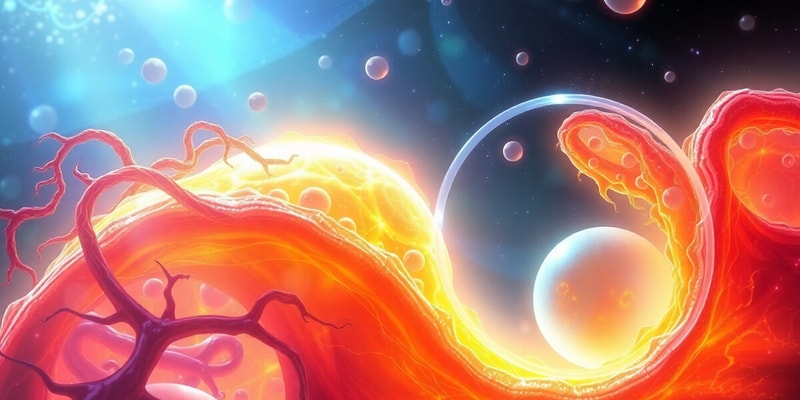Podcast
Questions and Answers
What is the main difference between asexual and sexual reproduction?
What is the main difference between asexual and sexual reproduction?
Which type of asexual reproduction involves an organism producing a small bud?
Which type of asexual reproduction involves an organism producing a small bud?
What is the outcome of the fusion of a sperm and an egg?
What is the outcome of the fusion of a sperm and an egg?
What process reduces the number of chromosomes in gametes to haploid sets?
What process reduces the number of chromosomes in gametes to haploid sets?
Signup and view all the answers
During spermatogenesis, which phase is first?
During spermatogenesis, which phase is first?
Signup and view all the answers
Which of the following correctly describes somatic cells?
Which of the following correctly describes somatic cells?
Signup and view all the answers
In oogenesis, which of the following phases is not a part of the process?
In oogenesis, which of the following phases is not a part of the process?
Signup and view all the answers
What type of organism typically reproduces through fragmentation?
What type of organism typically reproduces through fragmentation?
Signup and view all the answers
What is the primary function of spermatogonia during the multiplication phase?
What is the primary function of spermatogonia during the multiplication phase?
Signup and view all the answers
What is the end result of the maturation phase in spermatogenesis?
What is the end result of the maturation phase in spermatogenesis?
Signup and view all the answers
What is not a part of spermatozoa?
What is not a part of spermatozoa?
Signup and view all the answers
In which species is the sperm described as having a long, thin, and pointed shape?
In which species is the sperm described as having a long, thin, and pointed shape?
Signup and view all the answers
Which structure in the male reproductive system lines the seminiferous tubules?
Which structure in the male reproductive system lines the seminiferous tubules?
Signup and view all the answers
What is the chromosomal composition of secondary spermatocytes after the first meiotic division?
What is the chromosomal composition of secondary spermatocytes after the first meiotic division?
Signup and view all the answers
Which phase of spermatogenesis produces two secondary spermatocytes from one primary spermatocyte?
Which phase of spermatogenesis produces two secondary spermatocytes from one primary spermatocyte?
Signup and view all the answers
What structure is responsible for the energy production in spermatozoa?
What structure is responsible for the energy production in spermatozoa?
Signup and view all the answers
Study Notes
Embryology
- Embryology is the study of early development in living organisms.
- All animals and plants can reproduce to ensure the survival of their kind.
Reproduction
-
Asexual Reproduction: A single organism splits, buds, or fragments to create two or more individuals.
-
Types of asexual reproduction:
- Splitting: An organism splits into two individuals (example: Paramecium)
- Budding: An organism creates a small bud that grows on the parent and then breaks off to become a new individual. (example: Hydra)
- Fragmentation: An organism breaks into fragments, and each fragment develops into a new individual (example: Yeast)
-
Sexual Reproduction: Two gametes (sperm and egg) fuse to form a zygote (fertilized egg).
Sexual Reproduction - Types
- It needs one parent.
- The fusion of two gametes (male and female) to form a zygote (fertilized egg).
Stages of Sexual Reproduction:
-
The zygote undergoes embryonic developmental stages.
-
These stages involve the division of zygote cells, leading to a large number of somatic cells (cells that form the body).
-
The somatic cells contain a diploid number of chromosomes (2n) in each.
-
Before studying the embryonic stages, the formation of gametes (haploid - n) through gametogenesis must be studied.
Gametogenesis
- The creation of gametes (sperm and egg) from parents involves reducing the chromosome number to produce haploid sets in the resulting gametes.
- The body of an organism is made of somatic cells (2n) including organs like the testes (males) and ovaries (females).
- The primordial germ cells in the testis and ovary develop into either sperm or egg cells through the processes of spermatogenesis and oogenesis, respectively.
- These processes each have three phases.
Spermatogenesis
- Multiplication Phase: Primordial germ cells divide repeatedly by mitosis, creating many spermatogonia.
- Growth Phase: Spermatogonia grow into larger primary spermatocytes.
- Maturation Phase: Meiosis, consisting of two divisions, transforms the primary spermatocytes into spermatids, each with haploid chromosomes.
- Spermatids then develop into spermatozoa (sperm) through a process called metamorphosis.
Spermatozoa Anatomy
- Head: Contains the nucleus and acrosome.
- Midpiece: Contains mitochondria for energy.
- Tail: Contains flagella for movement.
Types of Sperm
- Different shapes exist in various organisms.
Oogenesis
- The formation of ova (eggs).
- It involves primordial germ cells in the ovaries, through specialized processes and phases, producing mature ova.
Testis Structure
- Testis are made up of seminiferous tubules.
- Walls of seminiferous tubules contain germinal epithelium
- These cells form primordial germ cells which produce sperms.
Ovary Structure
- The ovary's lining is the germinal epithelium with primordial germ cells which produce mature ova through oogenesis.
Studying That Suits You
Use AI to generate personalized quizzes and flashcards to suit your learning preferences.
Related Documents
Description
This quiz covers the fundamental concepts of embryology and the types of reproduction in living organisms. Explore the differences between asexual and sexual reproduction, along with their respective methods and stages. Test your knowledge on these essential biological processes.




